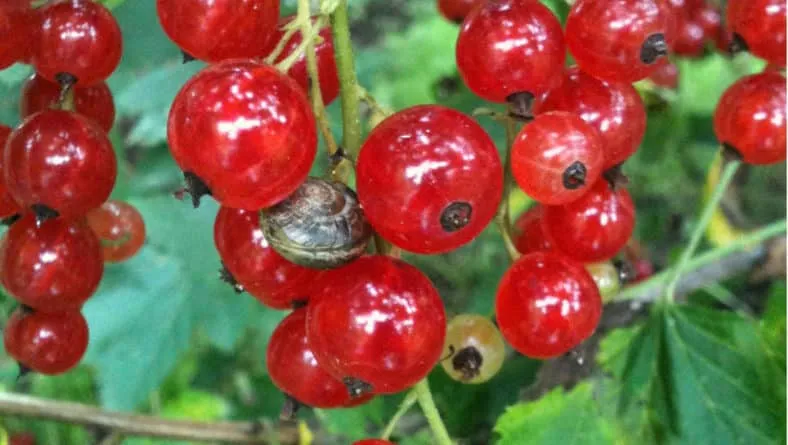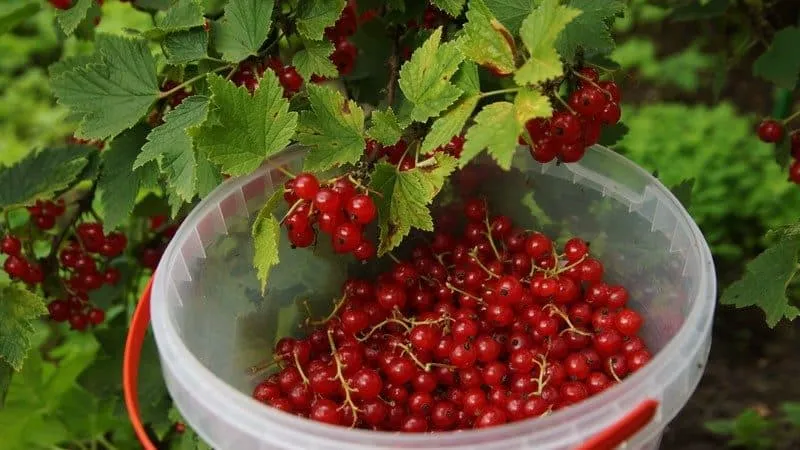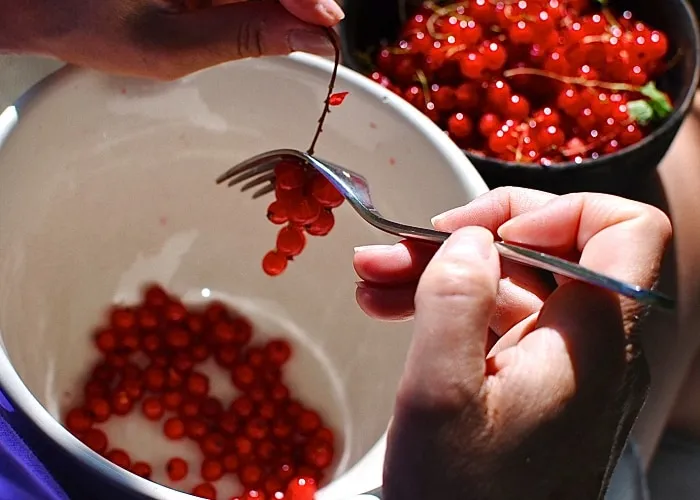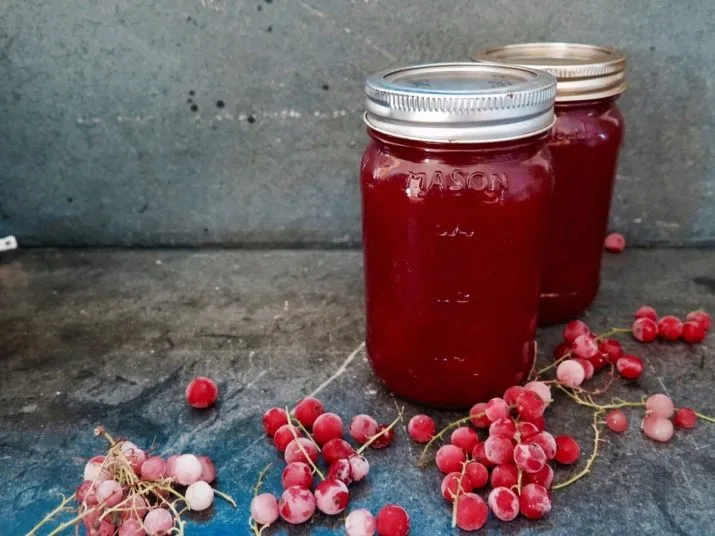Red currant – one of the most low-maintenance berry shrubs. The plant is resistant to both wet and dry weather and can thrive even in colder regions of Europe. The berries are rich in vitamins, minerals, and other beneficial compounds, making red currants a popular choice among gardeners.
To ensure the berries store well and provide maximum health benefits, it’s essential to harvest them correctly and at the right time. Picking red currants can be a lengthy and meticulous process, as each bush produces a large number of small, delicate berries. Read on to learn when and how to harvest red currants.
Table of contents
When to Harvest Red Currants
The ripening period for red currants depends on two factors – the region where they are grown and the variety. Warmer climates lead to earlier harvests.
Sunlight also plays a role. Berries ripen faster in direct sunlight, which is why younger bushes often yield fruit earlier than older ones, as their branches provide less shade.

Uniform ripening can be predicted by observing the flowering stage. If flowering is prolonged, berry maturation will also be gradual, taking 2-4 weeks. In this case, harvest as needed.
If the shrub flowers uniformly (all blossoms appear simultaneously and flowering is brief), the fruiting period will be short, and berries will ripen together. In this scenario, harvest all at once.
Unlike black currants, red currants do not drop easily. They can remain on the bush for weeks after ripening, so there’s no need to pick them immediately. Black currants, however, require multiple harvests as they ripen.
Note: On average, red currants ripen 2 weeks earlier than black currants.
By Growing Region
Harvest times vary depending on the climate.
Approximate ripening periods in different European regions:
- Central Europe (Germany, France, Belgium, etc.). Most varieties ripen by mid-July. Early varieties can be harvested in June.
- Southern Europe (Spain, Italy, Greece). The harvest season runs from early June to late July.
- Northern Europe (Scandinavia, the Baltics). From early to mid-August.
By Red Currant Variety
Wild currants typically ripen unevenly, with the first berries ready in early summer and the last in late August.
Ripening times vary by variety:
- Early varieties. These ripen first. In temperate climates, harvest begins in late June. Examples: Jonkheer van Tets, Rovada, Red Lake.
- Mid-season varieties. These ripen about 2 weeks later than early types, usually by mid-July. Examples: Rolan, Rosetta, Tatran.
- Late varieties. These ripen last, often by late August in cooler regions. Examples: Detvan, Versailles Red, Heinemann’s Rote Spätlese.
How to Tell When Berries Are Ripe
Red currants turn red before full maturity. Unripe berries are too tart for fresh eating or preserves.
Signs of ripeness:
- Colour. Fully ripe berries are deep red, without orange or green patches.
- Texture. Berries should be soft yet firm, yielding slightly to pressure.
- Taste. Ripe currants are sweet-tart. If they lack sweetness, they’re not ready.
- Stems. The twigs holding ripe berries turn yellowish.
- Ease of picking. Ripe berries detach easily, leaving a small amount of moist pulp on the stem.
Harvesting Slightly Unripe Berries
If currants are for sale and require long-distance transport, they can be picked slightly underripe. They should have a reddish hue but remain firm.
Unripe berries are not recommended for eating, as they lack full nutrient content and may aggravate digestive issues due to high acidity.
Underripe berries withstand transport better and can be stored for over 2 months. They ripen in the fridge over 2-4 weeks, though some vitamins are lost in the process.
Red Currant Harvesting Guidelines

Harvesting red currants is labour-intensive. The berries have delicate skin and must be picked by hand. Follow these rules:
- Pick berries as soon as they ripen. Overripe berries fall off, crack, and spoil quickly.
- Harvest early in the morning or at dusk when temperatures are cooler. Midday heat reduces berry quality and shelf life.
- Pick only in dry weather. Wet berries spoil faster.
- Since currants ripen unevenly, harvesting is often done in stages.
- Place berries gently in containers to avoid bruising. Lay them in even layers.
- Unlike black currants, red currants stay on the bush until all berries on a branch are ripe.
For best storage, harvest red currants with stems attached. Plucking individual berries damages their skin, causing juice loss and reduced shelf life.
At home, store berries on their stems. Remove stems only before use or processing.
If preserving immediately, berries can be picked without stems. Place them in containers in thin layers to prevent crushing.
Note: Black currants have tougher skin and are usually picked individually. White currants differ from red only in colour and taste – their harvest timing and methods are the same. White currants are also picked in clusters.
Quick Harvesting Methods
To speed up harvesting, experienced gardeners use these tricks:
How to pick currants faster:
- Spread a sheet or white cloth under the bush, covering the area beneath all branches.
- Use secateurs or scissors to snip off entire clusters. Let them fall onto the sheet.
- Once all berries are harvested, gather the sheet’s edges and pour the berries into a container.
Sorting and Preparing the Harvest

Post-harvest preparation involves these steps:
- Sorting. Remove leaves, debris, and any unripe, damaged, or mouldy berries. Discard clusters with mostly spoiled fruit.
- Cleaning. If preserving, rinse berries in cold water. Debris will sink, while berries float.
- Drying. Spread berries in a single layer on a towel or paper. Pat dry with a cloth. For faster drying, use a fan or cool hairdryer.
- Removing stems. Do this just before use. Gently pluck berries by hand or use a wide-toothed comb to strip them from stems.
If storing fresh, do not wash berries beforehand – this shortens shelf life. Wash only before eating.
Tip: A hairdryer on a cool setting can blow away debris. Lay berries in a single layer and gently blow off dust and leaves.
Storage Methods
Proper storage keeps berries fresh longer.
Refrigerator storage:
- Store clusters in ventilated containers or perforated bags.
- Ideal temperature: the fridge’s vegetable drawer (around 0-4°C).
- If your fridge has a "Fresh Zone," use it. Berries can last up to 2 months.
Freezing:
- Freeze whole clusters or individual berries.
- Spread berries in a single layer on a tray.
- Once frozen, transfer to portion-sized bags.
- For maximum nutrients, use flash freezing.
- Never freeze wet berries – they’ll stick together.
- For sweetened freezing, mash berries with sugar (to taste) and freeze in small containers. This preserves nutrients for up to 3 months.
Drying:
Two easy methods:
Method 1 (air-drying):
- Spread berries on paper or cloth in a well-ventilated, sunny spot.
- Turn every 2 hours. Drying takes 2-5 days.
Method 2 (oven-drying):
- Line a tray with parchment paper.
- Dry at 40-100°C (lower temps preserve more vitamins).
- Leave the oven door slightly ajar for 4-6 hours.
Preserves: Jams, jellies, and compotes are popular options.

Tips for better preserves:
- Use small jars (250-500 ml) to avoid waste after opening.
- Choose lacquered or glass lids. Metal lids can react with the berries.
- For jams, remove stems beforehand. For whole berries, clean thoroughly.
- Currants mixed with sugar can be stored in sealed jars in the fridge.
- Combine currants with other fruits, like lemon zest, for varied flavours.
Expert Tips

Seasoned gardeners recommend:
- Thaw frozen berries gradually: move from freezer to fridge, then to room temperature. Avoid microwaving or hot water. Never refreeze thawed berries.
- Frozen currants last over 3 months but lose nutrients over time.
- Mix berries before freezing for ready-to-use compot blends.
- Currant leaves are also useful – rich in vitamin C, they add aroma to teas. Harvest leaves during flowering (10-11 AM), dry in shade, and store in cloth bags.
Conclusion
Harvesting red currants is a meticulous task due to their delicate nature. Hand-picking clusters ensures minimal damage and extends fresh storage to 2 months.
Multiple preservation methods exist: refrigeration, freezing, drying, or making jams. While jams are delicious, freezing retains the most nutrients.







